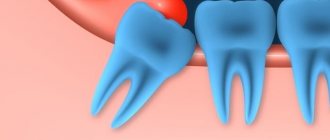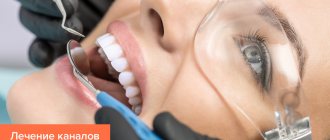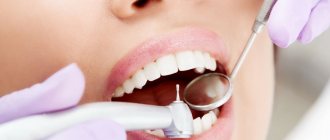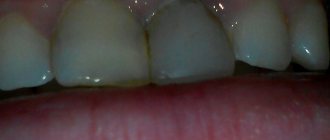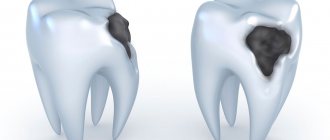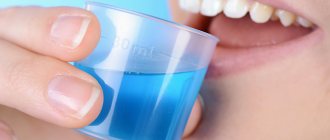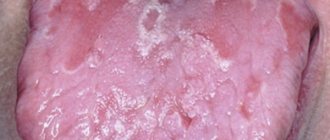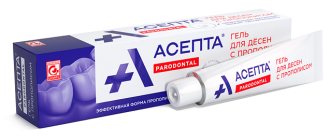- Questions and answers
- Stock
- Reviews
| Prices | Is it important to treat childhood caries? | Symptoms | Stages of caries | Treatment methods |
Caries of primary and permanent teeth occurs in 70-80% of children. This is due to the fact that children do not take good care of their oral hygiene and are partial to sweets. Do I need to treat the first teeth that will have to be removed anyway? What treatment methods are used in dentistry? How much does it cost to treat caries in children at the NovaDent clinic?
Prices
| Baby teeth | Price |
| Treatment of milk caries with placement of a filling made of glass ionomer cement | 2 350 ₽ |
| Treatment of caries with light polymerization fillings | 3 500 ₽ |
| Treatment of initial and superficial caries with Icon | 3 500 ₽ |
| Baby teeth | Price |
| Treatment of caries with filling made of glass ionomer cement | 2 350 ₽ |
| Treatment of caries with light polymerization fillings | 3 500 ₽ |
| Treatment of initial and superficial caries with Icon | 3 500 ₽ |
| Permanent teeth | Price |
| Temporary filling | 300 ₽ |
| Medical pad | 550 ₽ |
| Treatment of caries with placement of a light polymerization filling (anesthesia, cavity formation, antiseptic treatment, filling) | 2500 – 4 500₽ |
| Tooth restoration | 5 500 ₽ |
| Permanent teeth | Price |
| Temporary filling | 300 ₽ |
| Medical pad | 550 ₽ |
| Treatment of caries with placement of a light polymerization filling (anesthesia, cavity formation, antiseptic treatment, filling) | 2500 – 4 500 ₽ |
| Tooth restoration | 5 500 ₽ |
You can make an appointment with a pediatric therapist by multi-line phone or online on the website.
In our center, pediatric dentistry operates in the following clinics:
- Bratislavskaya, VDNKh, Verkhniye Likhobory, Krasnogorsk, Oktyabrskoye Pole, Petrovsko-Razumovskaya, Skhodnenskaya
Why is it necessary to treat childhood caries promptly?
- Deep dental caries in children can provoke dangerous complications, pulpitis and periodontitis, acute pain and loss of a dental unit. And due to the fact that young children are not able to tolerate pain, treatment of the disease in an advanced stage must be carried out under general anesthesia or sedation.
- The rudiments of permanent units are located under the milk ones. Serious infections and early removal of primary teeth can lead to dental problems in adulthood.
- Dairy milk is more porous in its structure, so caries in children progresses faster. If treatment is not started on time, after 3-6 months a small carious spot can lead to deep caries and pulpitis.
To detect the disease at an early stage, visit the pediatric dentist once every 3-4 months.
Factors for the occurrence of caries in children under 3 years of age
There are three groups of factors: a woman’s poor lifestyle during pregnancy, local and general. If a mother does not monitor her diet during pregnancy, abuses alcohol, smokes, and does not visit doctors, the likelihood of a baby being born with various diseases increases.
Of course, he will not have caries from birth, but it can develop after teething, for example, due to a lack of minerals in the body. A pregnant woman should lead a healthy lifestyle and include the following foods in her diet: milk, cottage cheese, nuts, fish, meat, liver, legumes, berries, fruits, chicken eggs and cereals.
Among the external factors for the development of caries in children:
- Poor hygiene. Children don't like to brush their teeth. At first, adults do this for them; at about a year old, children begin to learn to clean themselves. If the baby neglects this hygienic procedure, plaque accumulates on his teeth, which gradually turns into tartar. It is a favorable environment for the proliferation of cariogenic microbes.
- Impaired saliva production. Saliva contains substances that neutralize acids produced by bacteria. If the salivary glands do not work well, producing insufficient amounts of saliva, demineralization of the enamel occurs faster.
- Malocclusion. If a child’s teeth grow in different directions and the bite develops incorrectly, more hard-to-reach places appear in the oral cavity into which microbes penetrate.
- Consumption of large amounts of sweets. Cariogenic bacteria feed on carbohydrates. The fermentation process begins in the oral cavity. Sucrose is the most dangerous for humans, fructose is less dangerous.
Common factors for caries in children include:
- cardiovascular diseases;
- problems with the gastrointestinal tract;
- weak immunity;
- bad ecology;
- stress.
Dental caries in children occurs due to the influence of several factors on the body. In children, tooth enamel is just developing. It takes 2-3 years for teeth to become stronger. They are more vulnerable to germs. In addition, children often eat sweets. All this leads to the development of caries.
Symptoms of the disease
A child cannot always point out the source of pain and discomfort, so parents need to be especially attentive to their child’s behavior and monitor the condition of the oral cavity. The following symptoms should alert you:
- Refusal to eat, tearfulness while eating;
- Chewing food on only one side of the jaw;
- Painful sensations from hot, cold and sweet;
- Yellow or white spots, dark streaks on tooth enamel;
- Bad breath.
If you observe one or more of the signs listed above in your child, contact your dentist immediately.
Stages of caries
There are 4 stages of caries in primary teeth.
Elementary
– the stage of a carious stain is characterized by softening and demineralization of the enamel. The tooth surface loses its uniformity and becomes rough with white or light brown inclusions. At this stage, caries is asymptomatic.
Surface
– the destruction of the outer shell of the tooth continues, the shade of the enamel deteriorates, the nerve begins to react to temperature stimuli, sweet foods and drinks.
Average
– bacteria penetrate into the inner layers of the tooth, and the upper layers of dentin begin to deteriorate. At this stage, the carious cavity is clearly visible. Sensitivity to hot, cold and sweets increases.
Deep
– the infection spreads and affects an increasing proportion of dentin. At this stage of the disease, the risk of complications increases, including tooth loss.
What is caries: types and causes of the disease
Caries is the process of destruction of hard tooth tissues. Childhood caries develops rapidly: if in adults the transition from initial to deep caries takes years, then a child’s teeth can be affected in just a few months. As a rule, caries affects several baby teeth at once.
Types of caries of primary teeth according to the depth of damage:
- Superficial caries: a small cavity appears, the lesion affects only the tooth enamel. The child may experience sharp pain when eating sweet or sour foods. Treatment of the affected areas with fluoride-containing preparations is required.
- Medium caries characterizes the destruction of dentin. Damaged teeth react to thermal and taste stimuli. Treatment of moderate caries of primary teeth involves filling. If a tooth is loose and a permanent tooth is in a hurry to appear in its place, filling is pointless.
- Deep caries is the last stage of the disease, often accompanied by periodontitis, cyst formation, and gumboil.
Features of caries treatment in children
The dentist must treat small patients with care and choose the most gentle and painless treatment possible. In dental therapy for children, the doctor follows the following rules:
- The duration of the appointment is no more than 30 minutes
. - , application anesthesia
is mainly used , less often - infiltration anesthesia (injection). For pain relief, the same drugs are used as for adults, only in smaller doses. - Treatment of caries in young children is carried out without drilling
using gentle methods: fluoridation and the infiltration method (with the drug Icon). - To remove deep caries in children under 3 years of age, filling with glass ionomer cement or photopolymer composite is used, usually under general anesthesia or sedation.
How to prepare your child for treatment
It's no secret that children are afraid of dentists, and without reason. Today, dental procedures are performed quickly and painlessly. You just need to prepare your baby for treatment so that he doesn’t worry. Find a good specialist. Some doctors turn the treatment process into an interesting game and thereby distract the child from terrible thoughts.
Practice your visit to the dentist at home. Soft toys can also act as “patients”. Tell your child that both mom and dad go to the dentist. Choose a time to visit the clinic when your baby is alert and cheerful. Make up a story about how a doctor saves teeth from monsters. Never scare children with hospitals or doctors when they misbehave.
Check your child's teeth every few months. Get him used to brushing them twice a day. Buy a special children's brush with soft bristles. To make it more interesting for him to take care of his teeth, you can choose a brush stylized as a cartoon character. Similar hygiene products are available in our online store.
Treatment methods for caries of primary teeth
Initial and superficial caries of baby teeth can be treated without a drill. In young children, carious stains on tooth enamel are effectively removed by infiltration using the unique German Icon technology. Fluoridation is also widely used.
Treatment without drilling with Icon
The technique consists of applying a special paste to a previously dried surface, which restores the enamel and stops the development of caries. Icon is completely painless and does not require anesthesia.
Indications:
usually carried out 6 months after the complete eruption of a particular tooth, suitable for children over 2 years old.
Fluoridation
Treatment of the tooth surface with fluoride-containing pastes with calcium, which restore enamel. Remineralization is an effective, painless and absolutely safe procedure. Thanks to fluoridation of children's teeth, the enamel layer becomes denser and less vulnerable to the negative effects of bacteria and acids, which cause dental caries.
Indications:
used from an age when the child is able not to swallow the medicinal solution.
Fissure sealing
The essence of the method is filling grooves and tubercles on the tooth surface with special fluorine-containing materials. The technique protects against the penetration of pathogenic bacteria into the tooth and reduces the likelihood of caries by 90%. Fissure sealing is carried out in two ways: invasive and non-invasive.
Indications:
It is advisable to carry out no later than 2.5-3 years.
Important:
All treatment procedures are carried out only after professional cleaning of baby teeth.
Read more about the treatment of baby teeth.
Treatment of caries in early childhood
- Fluoridation. The second name of this method is remineralization. This is the saturation of the affected areas of enamel with minerals, its restoration. The tooth surface is treated with a special composition containing calcium, phosphorus, fluorine and other elements. The effect of this treatment lasts for about six months. Fluoridation is indicated for children from 6 years of age.
- Silvering. This method is outdated, but is still sometimes used. The surface of the tooth is coated with a 30% solution of silver nitrate, which destroys bacteria that cause caries. The procedure is absolutely painless. But after it the teeth become black, which can cause complexes in the child.
- Infiltration. A special gel is applied to the affected area of the tooth, which softens the tissue. Afterwards they are washed with an abrasive mixture. The area is then dried and covered with Icon Liquid Filling. The material hardens under a curing lamp.
- Ozone therapy. Ozone under pressure in a gaseous state is applied to the area of the tooth affected by caries. This does not cause any pain. The duration of the procedure is 10-20 seconds. Ozone destroys bacteria that cause tooth decay. After ozone therapy, tooth decay stops.
- Filling. The installation of fillings on baby teeth begins with the removal of dead tissue from the cavity. This is done with hand tools or a drill. The cavity is disinfected with a special composition and hermetically sealed. Upon completion, the surface of the filling is ground.
The filling material should be no harder than enamel. Otherwise, protrusions will form along the edges. Therefore, glass ionomer cements are used for children. They wear evenly and naturally together into enamel.
Some clinics use colored fillings for fillings. They are made from compomer and have no side effects.
Treatment of caries of permanent teeth in children
At the initial stage, caries of permanent teeth can also be cured without drilling or preparation. The same methods are used as in the treatment of primary teeth. Sealing the fissures of molar teeth is recommended as the most effective prevention of caries.
Filling is the main method of treating permanent teeth in children. Filling technology for children is practically no different from therapy for adults. For restoration in this case, photopolymer composites of the latest generation are more often used.
The permanent tooth is filled according to the following scheme:
- Preparation, cleaning of carious cavity;
- Treatment with an antiseptic drug;
- Restoration with photopolymer composite;
- Polishing and grinding of the filling.
Tooth restoration is carried out under local anesthesia. Doses are selected individually depending on the age of the child.
Complications
The enamel of baby teeth is not strong enough, and therefore even minor damage to the tooth by caries can lead to rapid destruction of tooth tissue. The most common complication of caries in primary teeth is pulpitis. As a rule, the disease is chronic and appears even in the presence of small carious cavities. Only a dentist can identify the disease, since despite the inflammatory process, the child does not experience discomfort for a long time.
If pulpitis is not treated, the complication develops into a more complex form; the infection affects the tissues surrounding the tooth root - periodontitis develops. Parents should regularly take their child for preventive examinations to the dentist, since advanced caries of baby teeth can lead to serious complications and cause the death of the permanent tooth germ.
Special offer
Participate in the promotion
Promotion “1+1”: child and parent
You have entrusted NovaDent with the treatment of your child’s teeth, as a token of gratitude we are giving you a free consultation with any specialist (surgeon, implantologist, therapist, orthodontist, hygienist), as well as an orthopantomogram (panoramic photograph of the teeth) sent by email.
Take time for your health and take advantage of this great offer! Participate in the promotion
Expert of the article you are reading: Lapshina Maria Aleksandrovna Dentist, pediatrician
21 years
Clinical experience
Krasnogorsk
Moscow region, Krasnogorsk, Podmoskovny Boulevard, 5
+7
Free consultation with this specialist

